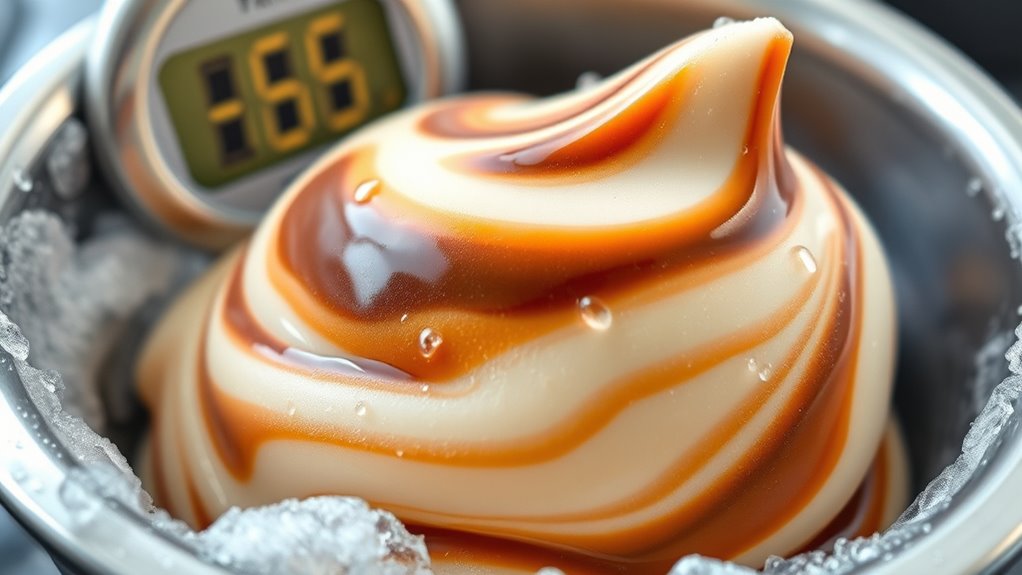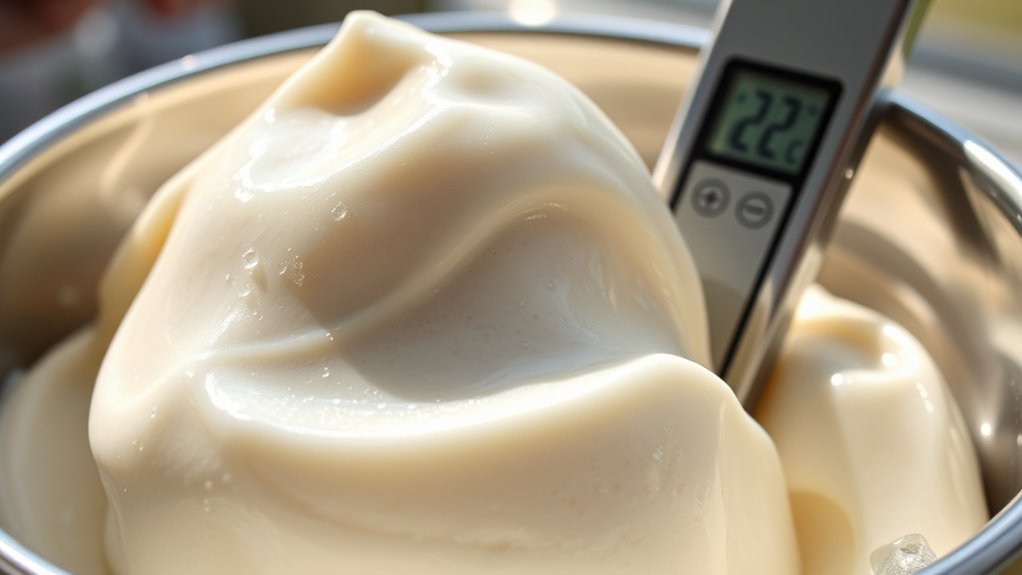Temperature plays a crucial role in gelato making because it impacts texture, flavor, and scoopability. Keeping gelato stored between -5 and -10°F prevents the formation of large ice crystals that can make it grainy or icy. Proper serving temperature, around 6 to 12°F, helps maintain its creaminess and makes scooping easier. If you’re curious about how to control and optimize temperature for perfect gelato every time, there’s more to explore below.
Key Takeaways
- Proper freezing temperatures (-5 to -10°F) prevent ice crystal growth, ensuring a smooth and creamy gelato texture.
- Excessively cold storage causes large ice crystals, leading to grainy and icy gelato quality.
- Serving gelato at 6-12°F enhances scoopability, flavor release, and overall mouthfeel.
- Maintaining correct temperatures during storage and serving preserves gelato’s structure and prevents premature melting.
- Advanced temperature management technologies help ensure consistent gelato quality and prevent detrimental fluctuations.

Temperature plays a vital role in gelato making, directly affecting its flavor, texture, and overall quality. When you serve gelato, maintaining the right temperature guarantees you experience its full creaminess and rich aroma.
Proper temperature control enhances gelato’s flavor, texture, and richness for an irresistible serving experience.
If the gelato is too cold, around 0°F, it becomes excessively hard and icy. This results in large ice crystals forming, which diminishes the smooth, velvety texture you seek. These ice crystals grow when the gelato’s temperature drops well below the freezing point, disrupting the delicate balance needed for a luxurious mouthfeel.
To avoid this, the ideal storage temperature for gelato during its shelf life should be between -5 and -10°F. This range prevents recrystallization, which occurs when ice crystals melt and refreeze, making the gelato grainy and less enjoyable.
When you’re ready to serve, proper tempering is essential. Letting the gelato sit at room temperature for about 10 to 15 minutes helps it reach an optimal serving temperature of 6 to 12°F.
At this point, the gelato becomes scoopable without melting immediately. Serving it too cold, at around 0°F, makes it difficult to scoop and can compromise its creaminess. Warmer temperatures above 12°F cause the gelato to melt quickly, losing its structure and flavor release.
Achieving the ideal temperature guarantees the gelato retains its smooth texture and rich flavor profile while being easy to serve.
The temperature you keep your gelato at during storage and serving directly influences the overall eating experience. If stored at too high a temperature, the gelato begins to soften prematurely, risking melting and flavor loss.
Conversely, overly cold storage leads to the formation of large ice crystals, which interfere with the delicate structure. Proper freezing and storage at the specified temperatures preserve the gelato’s integrity and help maintain its softness and scoopability over time.
Additionally, automation in food preservation technologies are increasingly being used to monitor and maintain optimal gelato temperatures automatically, ensuring consistent quality.
When you serve gelato at its optimal temperature, you unlock its full potential—rich, creamy, and perfectly textured.
Frequently Asked Questions
What Is the Best Temperature for Gelato?
The best temperature for gelato is between 10°F and 22°F (-12°C to -6°C).
You should serve it slightly warmer than traditional ice cream to enjoy its full flavor and smooth texture.
When storing, keep it around 8°F to 12°F (-13°C to -11°C) to maintain freshness without making it too hard.
Precise temperature control guarantees your gelato stays creamy, flavorful, and easy to scoop.
What Makes Gelato so Creamy?
You might wonder what makes gelato so creamy. It’s the lower fat content, which allows for more water and a smoother texture. Serving it at slightly warmer temperatures keeps fats and proteins more soluble, enhancing that velvety feel.
Plus, the high ratio of milk solids and stabilizers prevents large ice crystals from forming. All these factors work together, giving gelato its rich, creamy, and irresistibly smooth consistency.
How Does Temperature Affect the Texture of Ice Cream?
You see, temperature directly influences ice cream’s texture. When it’s too cold, below -18°C, it becomes hard and icy, making it difficult to scoop and less creamy.
If it’s too warm, above 12°F, it melts quickly and loses its structure. Keeping it within the ideal range of 6-12°F guarantees a smooth, elastic texture and maximum flavor release.
Consistent temperature control keeps your ice cream perfectly creamy.
Why Is Gelato Served Warmer?
Think of gelato as a delicate dance, where temperature guides every step. You serve it warmer because it keeps the dessert soft and inviting, not icy or hard as stone.
This warmer temp releases richer flavors and aromas, making each scoop a sensory delight. Plus, it prevents ice crystals from forming, ensuring your gelato stays smooth and creamy, perfectly balancing firmness and decadence for an irresistible experience.
Conclusion
Understanding the importance of temperature in gelato making is key to achieving that perfect texture and flavor. Did you know that even a two-degree difference in storage temperature can change gelato’s creaminess? So, pay close attention to your freezer and mix temperatures carefully. When you control the temperature right, you’ll consistently serve silky, delicious gelato that keeps your customers coming back for more. Temperature isn’t just a detail—it’s the secret to gelato perfection.









